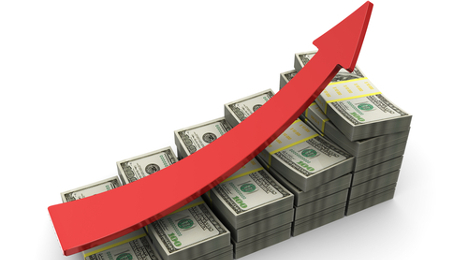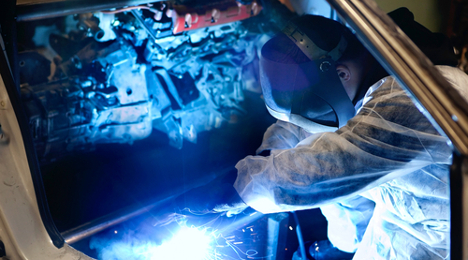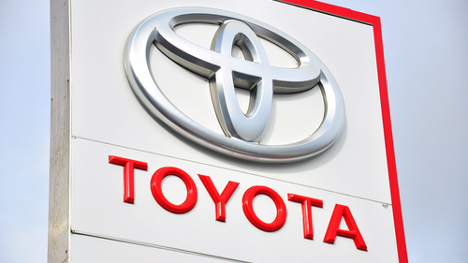Group 1 Automotive president and chief executive officer Earl Hesterberg described a predicament franchised dealerships might be facing as more new trucks and SUVs leave their showrooms.
Part of the fallout from those popular new models turning is what’s coming back as a trade — perhaps a sedan that’s not as popular as those trucks and SUVs that are back in vogue thanks to modest fuel prices, among other factors.
“It’s not a demand issue at all. It is an increased supply issue primarily,” Hesterberg said when Group 1 hosted its most recent quarterly conference call in part to discuss its used-vehicle performance.
“It’s an increased supply issue, and also I believe there is a mix issue of a greater supply of used cars over used trucks and SUVs,” he continued. “So the dynamic in the new-vehicle land of trucks and SUVs being in greater demand than cars is same in the used-vehicle market, and many new vehicle customers are trading in a car and moving to an SUV or a truck.
“Then those trade-ins get pushed into the used retail market,” Hesterberg went on to say.
And it’s likely those vehicles aren’t in high demand, especially if they’re compacts. Cox Automotive chief economist Tom Webb mentioned a wholesale price decline of nearly 10 percent yet again for that kind of vehicle when Manheim released its most recent Used Vehicle Value Index.
So to keep showroom activity buzzing, Hesterberg noted how Group 1 is active in dialogue with automakers on how to control the inventory at least on the new-vehicle side.
“All retailers such as ourselves have been communicating to the OEMs that we don’t have enough trucks and SUVs. I think that's been pretty clear,” Hesterberg said.
“And we're at the point now where we're in discussions with most of our OEM partners that we just can’t take any more inventory at the moment, at least in terms of a days’ supply,” he continued.
“We need to work it down a little bit. And actually our total inventory only went up two days year-over-year. But what's within that is skewed too heavily to cars, which are not moving as well,” Hesterberg went on to say.
Update on U.S. store count
During 2015, Group 1 acquired three dealerships, which executives expect to generate an estimated $340 million in annual revenues. The company also disposed of five dealerships that generated approximately $115 million in trailing 12-month revenues.
Within the first 45 days of this year, Group 1 noted, it disposed of two dealerships that generated approximately $75 million in trailing 12-month revenues.
As a result, investment observers wanted to know how Group 1 might modify its U.S. store footprint, which includes 114 dealerships mainly in Texas and along the Gulf Coast.
“I can’t really say I've seen the ask prices on dealerships for sale go down yet. My personal opinion is the pricing for acquisitions peaked in the U.S. over a year ago,” Hesterberg said.
“That’s one of the reasons we did not buy very much last year,” he continued. “I think we bought three different dealerships, and intentionally, all of them are outside of the oil patch and they were luxury brands. Pretty valuable assets we think.
“I think that will take some time for the pricing to get more realistic in the market,” Hesterberg went on to say. “I would think that with the margin pressure and a lot of the volatility in the stock market and such that all buyers would be a little more cautious this year, but I expect them to take a little more time for the pricing to adjust to a new psychology.”
If you’re embracing technology as a dealer, you’re likely already swimming in a sea of acronyms. You’ve got your CRM. Your DMS. You’ve got things covered from SEO all the way to F&I. But perhaps a lesser known acronym, VRM, or vehicle relationship management, seems to have a bit more vague definition depending on whom you ask.
But if you ask Roger Penske, Penske Automotive Group’s chairman and chief executive officer, what VRM means to him, he may tell you how it means trying to hold on to a car throughout the retail process, from the first sale all the way to its third, perhaps.
Penske Automotive hosted its fourth-quarter and full-year financial results conference call on Thursday, and one question fielded by Penske resonated with the topic of VRM: How does Penske Auto see the impending used-vehicle volume increase from the expected wave of off-lease vehicles? Is it a certified pre-owned opportunity? What’s the net effect on the company?
Pointing out that used inventory is actually down by roughly 1,000 units overall from where they were a year ago, Penske said he sees it as an opportunity to not only work on customer loyalty, but also keep the cars coming back again and again to bolster gross profits.
“I’ll give you a quick example,” he said. “In Atlanta, where we have two BMW stores that do over 300 used cars a month, probably 10 percent would be coming out of their loaner car fleet every month, another 10 percent would be non-BMW trades, and the rest are BMW.
“I think the ability for us to be able to recondition those, we get the benefit of that in our shops, in the parts and service, and then the ability to utilize some of the OEM’s programs,” Penske said. “That’s one of the things I don’t think people realize … both Mercedes and certainly BMW — and I know Toyota does — they have some very attractive programs on used cars that come out of loaner service or come off lease. Especially if you CPO them. So we’re going to take advantage of those.”
Penske says the company is aiming for a 50 percent to 60 percent loyalty rate from his off-lease customers – whether that means they re-lease that same car, buy it, or choose to lease or buy another vehicle. Keeping that initial vehicle to be sold again and again — that’s Penske’s idea of VRM.
“We want to keep that vehicle, we want to take the vehicle from the customer off-lease, we want to sell or lease it to a second person and then get it back and then retail it at the end,” Penske said. “There’s some real opportunity for gross profit on each vehicle. We don’t want to lose those vehicles as they come through the cycle.”
Penske Automotive Group released its fourth-quarter and full-year financial results on Thursday, claiming 2015 as the most profitable year in company history.
This was powered, in part, by an 8.98-percent year-over-year increase in total global used-vehicle sales, which reached 198,459 units. This contributed to the group’s increase in total automotive retail units of 11.9 percent compared to 2014. Excluding foreign exchange, Penske’s total revenue in 2015 increased by 14 percent.
Roger Penske, the group’s chairman, highlighted the impetus behind his company’s year of growth.
“The diversification provided by our business model continues to drive our business forward,” he said. “Our U.K.-based retail automotive and U.S.-based commercial truck businesses produced exceptional results, and the stability of the parts and service business helped our business produce another solid quarter. We expect 2016 will be another solid year for both automotive and U.S. commercial truck sales.”
Here’s a breakdown of Penske Automotive’s fourth-quarter and full-year 2015 results, from the used-car sales angle, on a global scale.
Penske Automotive's 2015 Used-Vehicle Retail Results
| |
Fourth-Quarter 2015 (2014 comp.) |
Full-Year 2015 (2014 comp.) |
| Units Retailed |
|
|
| Same Store |
45,150 (44,136) |
189,548 (180,155) |
| Overall |
49,741 (44,136) |
198,459 (182,109) |
| Revenue (millions) |
|
|
| Same Store |
$1,271.3 ($1,197.3) |
$5,233.3 ($4,924.9) |
| Overall |
$1,364.8 ($1,197.3) |
$5,425.5 ($4,971.1) |
| Gross Profit (millions) |
|
|
| Same Store |
$69.6 ($73.1) |
$322.4 ($332.8) |
| Overall |
$70.7 ($73.1) |
$328.3 ($335.5) |
According to a release from Penske, the group acquired retail automotive franchises and U.S. commercial truck dealerships that are expected to generate roughly $500 million in estimated annualized revenue.
There are over 47 million vehicles in the United States that have at least one unrepaired safety recall. That’s according to a recent analysis from Carfax, who pointed out that these 47 million vehicles are being driven, bought and sold, or sitting on a lot somewhere in our country, either because there’s not a fix available or because they're waiting on one or whoever owns the vehicle simply hasn’t taken the time to take it in.
To put that number in perspective, the current U.S. population is just short of 323 million (and has netted roughly 20 new Americans in the time it took to write this article) according to the United States Census Bureau.
Carfax says that 47 million number is more than a 1 million net increase in unrepaired recalled vehicles compared to last year. And every state in the union has at least 100,000 of them within its borders.
"Our data shows there's still much hard work to be done in addressing recalls," Carfax communications director Larry Gamache said in a news release. "Many people still are unnecessarily risking their lives by not staying informed or taking action when their vehicle is under a recall. It's one of the many reasons family-oriented vehicles, including one in four minivans, are the most-highly impacted. Carfax continues to work closely with the auto manufacturers so we can alert people in the U.S. and Canada that their vehicles have a potentially dangerous defect that needs to be fixed."
In a recent interview with Auto Remarketing about a separate recall-related matter, Karl Brauer, Kelley Blue Book’s senior director of automotive industry insights, discussed the changing environment of automotive recalls — which historically have carried a “fairly low priority.”
“Consumers, by the way, are just as much of a problem as the government or the dealers, because they have a horrible record of taking the vehicles in when they’ve gotten their notice,” Brauer said. “I don’t know what it is today, but in the past if you got anything over 50 percent of all vehicles involved in a recall to actually be processed and have it addressed, that was considered relatively good. And anything over 66 to 70 percent was like a home run… I just don’t think the patience now exists for that attitude.”
Citing data from the National Highway Traffic Safety Administration, Carfax points out that more than 51 million recalls were issued in 2015, more than any year prior.
"Millions more vehicles will likely be recalled this year, adding to the ones already with outstanding airbag recalls, ignition switch recalls, electrical system recalls and more,” Gamache said. “Resources like myCarfax that continuously monitor your car and send alerts to your mobile device are helping people everywhere find and fix more recalls.”
The good news for Group 1 Automotive’s used-vehicle department: The dealer group turned 12.1 percent more used models in 2015 than its stores did a year earlier.
The not-so-good news for Group 1's used performance: Margins on those retail sales softened by 6.3 percent year-over-year.
Company officials shared their fourth-quarter and full-year financial report on Thursday and highlighted that Group 1 stores retailed 105,211 used vehicles in 2015. The average retail price for those used units rose 2.2 percent to $20,955.
However, the gross profit on those used turns settled just below $1,500. According to Group 1, it came in at $1,498, a $100 decline.
On the new-vehicle side, Group 1 sustained a similar drop-off in gross profit as the full-year reading dipped by $94 or 5.3 percent to $1,691. But also like its used-vehicle department, Group 1 moved more new metal as 142,256 units rolled over the dealer group’s curbs in 2015, a 5.1-percent rise year-over-year.
Also of note among the full-year gross profit readings, Group 1 reported its F&I margins came in almost identical year-over-year. The F&I gross profit stood at $1,515 per retailed unit in 2015 after registering in at $1,521 a year earlier.
Eventually, the turning of all of those new and used vehicles as well as F&I activity propelled Group 1 to a full-year adjusted net income record.
The company generated a 9.0-increase in adjusted net income to a record $165.5 million, and adjusted diluted earnings per common share increased 17.0 percent, to an all-time high of $6.87.
Group 1 also highlighted total revenue grew 7.0 percent to a record $10.6 billion.
On a GAAP basis, net income increased 1.1 percent from the comparable prior-year period to $94.0 million.
“While we delivered a record year in total for revenue, gross profit, and adjusted diluted earnings per share, our fourth quarter results were significantly hampered by the negative impact of continued oil and gas price decreases on the economy in our prime markets of Houston, Oklahoma and Texas in general,” Group 1 president and chief executive officer Earl Hesterberg said.
“Additionally, we suffered from increased new and used vehicle margin pressure resulting from oversupply in a variety of key brands, especially in the U.S. luxury segment,” Hesterberg said.
Despite the headwinds Hesterberg referenced, Group 1 indicated its total Q4 revenue increased 5.3 percent — or 8.2 percent on a constant currency basis — to $2.7 billion. And total gross profit grew 3.9 percent to $380.1 million.
The company noted its Q4 retail used-vehicle revenues increased 11.0 percent on increased unit sales of 10.0 percent. For the quarter, retail used-vehicle gross profit was flat at $40.7 million, as margins decreased 9.2 percent or $136 per unit, to $1,346.
On the new-model side, Q4 revenues rose 3.2 percent on 3.0 percent higher unit sales. New-vehicle gross profit for Group 1 decreased 3.7 percent to $80.1 million as margins decreased 6.6 percent or $130 per unit to $1,843.
Also in Q4, F&I gross profit per retail unit was flat at $1,374 per unit.
Editor’s note: Watch for a report in an upcoming installment of Auto Remarketing Today detailing how Group 1 Automotive is navigating the challenges associated with its used-vehicle inventory as well as acquisition possibilities.
Q auto, the standalone used-car program that Asbury Automotive Group launched in the spring of 2014, is still a work in progress and a learning experience — a “laboratory,” if you will. And one that the group thinks has some promise.
But 2016 is the year Asbury’s management hopes it turns a corner. The company aims for those stores to begin pulling a solid return on investment. Asbury has three Q auto locations, each of which is in Florida (locations are in Brandon, Fort Myers and Jacksonville, respectively).
“Q auto lost two cents in this quarter. It had been losing somewhere in that one- to two-cent range, so we’re kind of right where we thought we’d be. I would say it continues to be something that we feel very good about,” Asbury chief executive officer Craig Monaghan said during the Q&A portion of Thursday’s earnings conference call.
“It is a laboratory,” he added. “And we shouldn’t kid ourselves. We continue to learn. We’ve been changing some of our marketing efforts with Q. We’ve co-branded one of the stores with the local, regional name. But I think we need some more time.
“I think this is the year for Q,” Monaghan said, “where our internal objective is to get it to the point where those stores are generating an attractive ROI.”
What may help on the ROI front is that there’s not a lot of capital “tied up” in the stores, particularly for the two smaller-format locations, according to Monaghan, who said Q is seeing an “interesting impact” from digital marketing.
One of the three Q auto stores, he said, has had a far stronger performance than the other two. Monaghan said the most challenges have actually come from the larger format store.
“But we think there’s still an opportunity there and it’s something we’re going to continue to pursue,” Monaghan said.
Another interesting nugget on Q auto from Thursday’s call: most of its sales are in the subprime credit tier.
Group 1 Automotive announced several key company changes on Thursday, including the acquisition of a dealer group in the U.K., the divestment of three of its current dealerships, and three internal promotions.
The group has acquired the Spire Automotive Group, which includes 12 dealerships that operate primarily in the north and northwest London area. The acquisition includes four Audi stores, three BMW/MINI stores (with a BMW Aftersales center), two Seat dealerships, one Skoda dealership, one Volkswagen commercial vehicle dealership, and one Jaguar store.
Continuing to operate under the Spire name, the collection of stores is expected to generate roughly $575 million in annualized revenues.
"We are pleased to expand our relationship with BMW and the Volkswagen Group in the U.K. and to expand our relationship with Jaguar Land Rover from Brazil to the U.K.,” said Earl J. Hesterberg, the group’s president and chief executive officer. “We are also delighted to further leverage our scale and strong operating management team in the U.K."
Focusing back on the States, Group 1 has divested three dealerships, including Mercedes-Benz and Volkswagen of Freehold, N.J. and Ira Toyota of Milford, Mass. Collectively, these dealerships generated approximately $160 million in trailing 12-month revenues.
"We continually evaluate our portfolio of dealerships relative to required future capital expenditures and current levels of return on investment and move to dispose of assets that do not offer appropriate returns on invested capital," Hesterberg said.
On the senior management side of the group, the company’s vice president of human resources, Brooks O’Hara, has announced his retirement effective April 1. In response, the following transitions were made effective February 1:
- Frank Grese Jr. named senior vice president of human resources, training, and operations support. (Was regional vice president of the west region)
- Daryl Kenningham named egional vice president of the west region. (Was regional vice president of the east region)
- David Fesmire named regional vice president of the east region. (Was market director of the Houston/Beaumont and Gulf Coast markets.
After making its first DCH acquisition in late January, Lithia announced the second in line with the purchase of a Massachusetts Toyota store.
Lithia Motors has bought Ira Toyota/Scion of Milford, Mass., and the store will be renamed DCH Toyota/Scion of Milford.
The company said it expects the store will bring with it $65 million in estimated revenues.
Bryan DeBoer, Lithia president and chief executive officer, said, "We are pleased to announce the first East Coast acquisition within our metropolitan market strategy with DCH Toyota/Scion of Milford. This is the second store acquired by DCH and complements the Riverside Subaru acquisition announced last week.
“DCH Toyota/Scion of Milford is our first store in the state of Massachusetts and provides a platform for expansion into the greater Boston metropolitan area. We remain focused on continued acquisition growth within both rural and metropolitan markets in the future,” he continued.
This is the second purchase for the DCH brand after Lithia acquired DCH Auto in 2014.
Tom Folliard plans to retire from his role as CarMax chief executive officer prior to the end of 2016, with Bill Nash expected to take on the reins at that point, the company announced Monday.
Here’s how the changeover will work:
As the result of a multi-year management succession plan, Nash — previously executive vice president of human resources and administrative services — officially became CarMax president Monday.
And Cliff Wood — previously executive vice president of stores — became chief operating officer, a move also effective Monday.
Folliard intends to retire as CEO before the year ends, and then Nash would step in as CEO. The CarMax board of directors expects Folliard will stay on as the non-executive chairman of the board.
“Tom Folliard has built an exceptional management team at CarMax, positioning the company for continued growth,” said Bill Tiefel, chairman of the board. “The execution of our long-term succession plan, with Bill as president and Cliff as COO, ensures a seamless management transition and the continuity of the company’s culture.”
Folliard has been president and CEO since May 2006. He has worked at CarMax for 23 years.
Nash became EVP of HR and administrative services in 2012 and has been with the company since 1997.
Wood has been with CarMax since 1993 and became EVP of stores in 2012.
Sixteen percent of AutoNation’s used-vehicle inventory was unable to be sold at the end of last year due to its own internal policy to not sell any vehicles with open safety recalls. Add that to the less than 2 percent of their new-vehicle inventory affected by the same policy, this represents roughly 6 percent of all of AutoNation’s inventory that it had grounded at the close of 2015 for this reason.
Bill Berman, AutoNation’s executive vice president and chief operating officer, says this policy, which AutoNation put in place last year, has certainly impacted the company’s used-vehicle sales – but will prove to be worth it.
“We continue to implement systems and processes in support of our efforts to ensure no vehicle with an open recall is retailed,” Berman said. “We continue to believe the long-term safety benefits for our customers far outweigh the short-term impact to our results and further support the AutoNation brand promise.”
Pointing out that the recall policy has virtually no impact on new-vehicle sales, AutoNation chairman, chief executive officer and president, Mike Jackson, believes the short-term discomfort the recall policy is having will iron out within the first half of 2016 and will eventually be a selling point for its customers.
“It’s a significant impact on preowned. Just to discuss the issue for a moment, I think the auto industry really had some credibility issues it has to face up to,” Jackson said. “Everything from some of these horrific recalls we’ve had with significant loss of life to credibility issues around the Volkswagen situation. So we sit there and say, you know, what can we do on our part to make it better? So on preowned it’s a significant issue. On any given day 15 percent of our inventory has open recalls.
“These are significant safety recalls and we feel the time has passed that it’s appropriate to take a vehicle in trade with a significant safety recall and turn around the next day and sell it to a consumer,” he continued. “We’re the only one that’s done it, we think it’s a brand attribute, we will work to make it a brand attribute in 2016, and we feel in the long term it will be a tremendous advantage to us. In the meantime, it’s very disruptive to our used-car business because we see no way to get it below 15 percent with new recalls arriving every day. So we have to increase inventory to get to the same point.”
Although Jackson does say that the disruption from these recalled vehicles being grounded impacted used sales, he thinks there is a bigger issue for the industry that “pulls the rug out from under” AutoNation’s used-car inventory: new-vehicle incentives.
“I think the biggest threat to used-car values are additional incentives from the manufacturers, or additional discounts from us,” Jackson said. “That’s the big-picture issue. So it’s very interesting, our fourth quarter performance, where manufacturers are increasing incentives by $250 a car, us increasing our discount by $20 a car, that had an immediate impact on our used-car values. And then we had to discount anything that was relatively new versus the new vehicle on the showroom floor. It’s a double impact. It impacted our new-vehicle gross margin. It impacted our used-vehicle gross margin. That’s the biggest issue and that’s my greatest concern about over-production.”
Jackson said he hopes incentives won’t go further into the double-digit percentages than they currently are, which he said is roughly 10 percent, because it disappoints his dealer base and his customers by depreciating their trade-in values.
To check out AutoNation’s fourth-quarter and full-year sales results for 2015, click here.












